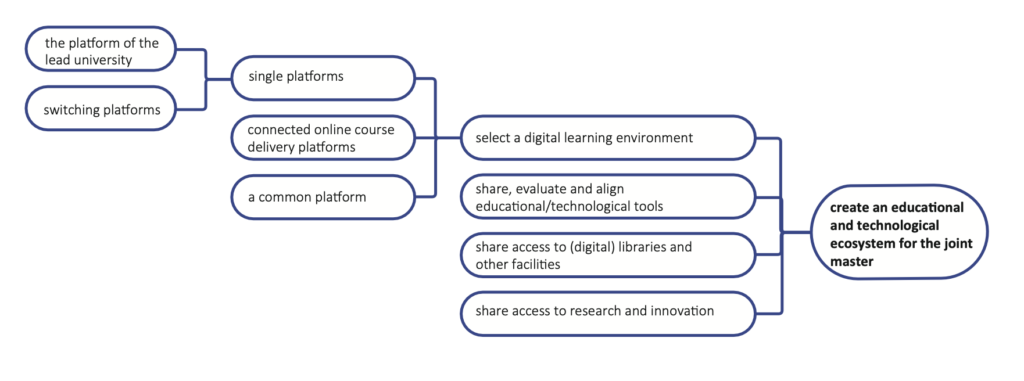
| The partnership has to take decisions on sharing a joint educational and technological ecosystem for the joint master’s programme: |
| • Choose a digital learning environment; |
| • Share, evaluate and align tools; |
| • Share access to digital libraries and other facilities |
| • Share access to research and innovation |
Choose a digital learning environment
Determine on which learning environment / platform partners will organize learning activities.
A first option is that all partners organize online learning activities on one learning platform, preferably the platform of the leading university, which is comfortable for the learners as they do not have to switch platforms during the programme.
A second option is that learners do indeed switch learning platforms when starting a course at another partner university, which is probably comfortable for teaching staff, but less so for students. In this case, the platform is linked to the course followed. The learning platform is the linked to the physical mobility paths in the joint programme: students switch platforms as the curriculum progresses. In this case, teachers can easily use software and extensions that are linked to the learning platform they are used to.
A third option is that institutional learning platforms are interconnected. In alliances of European Universities (EUI), many courses are planned to be organized together in a blended or online format. In this case, it makes sense to look for a smart connection between institutional platforms in the alliance for all collaborative courses and programmes
and mobility schemes. OpenU prepares middleware for making such connections.
A fourth option would be to support online courses and programmes on a national or European platform accessible to all learners. Such a common platform supports universities and teaching staff in the design of courses and programmes, including interactive learning communities. Some countries, such as Finland, are experimenting with such national platforms.
In practice, the European MOOC platforms already fulfill this task for online courses (MOOCS) and (MOOC-based) programmes up to university level, in particular (eg Futurelearn; France Université Numérique, FUN; Miriadax; EduOpen).
Share, evaluate and fine-tune tools
See above under “design the joint curriculum Share, evaluate and fine-tune tools
Share access to digital libraries and other facilities
Share access and guide students in using resources in digital libraries in the respective partner universities and faculties, extending and enhancing their learning environment for assignments, project or thesis work.
Provide students with access to other institutional facilities such as digital labs, simulations, learning games, where applicable.
Share access to research and innovation
At universities, research, innovation and education are intertwined (the knowledge triangle). Ensure students have access to relevant research and innovation in the partnership, for example for preparing projects and thesis work.
Select a digital learning environment
Decide on which learning environment/platform partners will organize their learning activities.
A first option is that all partners organize online learning activities on a single learning platform, preferably the platform of the leading university, which is comfortable for the learners as they don’t have to switch platforms during the course of the programme.
A second option is that learners indeed switch learning platform when they start a course at another partner university, which is probably comfortable for teaching staff, but less for students. In this case, the platform is connected with the course followed. Actually, this is connected with the physical mobility paths in the joint programme. Students switching
university as the curriculum proceeds. Teaching staff can easily use software and extensions connected with the learning platform they are used to.
A third option is that institutional learning platforms or connected with each other. In European University alliances (EUI), many courses are planned to be co-organized in a blended or online format. In this case, it is useful to look for a smart connection between institutional platforms in the alliance, serving all collaborative courses and programmes
and mobility schemes. OpenU is preparing middleware for making such connections.
A fourth option would be that online courses and programmes are supported on a national or European platform, accessible for all learners. On such common platform, universities and teaching staff are supported for designing courses and programmes, including interactive learning communities. Some countries, eg Finland, experiment with such national platforms.
In practice, the European MOOC platforms fulfil already this task for online courses (MOOCS) and (MOOC-based) programmes up to a degree level, notably (eg Futurelearn; France Université Numérique, FUN; Miriadax; EduOpen).
Share, evaluate and align tools
See above, under “design the joint curriculum Share, evaluate and align tools
Share access to digital libraries and other facilities
Share access and guide students to use resources in digital libraries in the respective partner universities and faculties, extending and strengthening their learning environment for doing assignments, project or thesis work.
Give students access to other institutional facilities such as digital labs, simulations, learning games, where appropriate.
Share access to research and innovation
In universities, research, innovation and education are intertwined (the knowledge triangle). Make sure that learners have access to relevant research and innovation in the partnership available on databases, websites and learning environments, for example to research documents, thesis work, webinars, projects and conferences.
next chapter: Install a language policy
previous chapter: Agree on qualifications
back to overview: Models and guidelines for the design and development of joint master’s programmes
